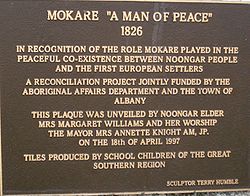
Mokare
Encyclopedia


Noongar
The Noongar are an indigenous Australian people who live in the south-west corner of Western Australia from Geraldton on the west coast to Esperance on the south coast...
man, an Aboriginal man from the south-west corner of Australia
Australia
Australia , officially the Commonwealth of Australia, is a country in the Southern Hemisphere comprising the mainland of the Australian continent, the island of Tasmania, and numerous smaller islands in the Indian and Pacific Oceans. It is the world's sixth-largest country by total area...
who was pivotal in aiding European
European ethnic groups
The ethnic groups in Europe are the various ethnic groups that reside in the nations of Europe. European ethnology is the field of anthropology focusing on Europe....
exploration of the area. Mokare had two known brothers: Mollian (d. 1829), who may have been known as Yallapoli, and Nakina, who with Mokare, was a frequent visitor to the Albany
Albany, Western Australia
Albany is a port city in the Great Southern region of Western Australia, some 418 km SE of Perth, the state capital. As of 2009, Albany's population was estimated at 33,600, making it the 6th-largest city in the state....
settlement, staying with the government resident, Dr Alexander Collie
Alexander Collie
Dr Alexander Collie was a Scottish surgeon and botanist who journeyed to Western Australia in 1829, where he was an explorer and Colonial Surgeon.-Early life:...
. He also was recorded as having a married sister.
Possibly first recorded as the charismatic "Jack" recorded by Phillip Parker King in his expedition to King George Sound
King George Sound
King George Sound is the name of a sound on the south coast of Western Australia. Located at , it is the site of the city of Albany.The sound covers an area of and varies in depth from to ....
in 1821, Mokare was from the Minang clan of Noongar. With the arrival of Major Edmund Lockyer in the brig Amity
Brig Amity
The Amity was a 148 ton brig used in several notable voyages of exploration and settlement in Australia in the early nineteenth century.She was built in New Brunswick, Canada, in 1816 and for several years was used as a merchant trading vessel between America and Britain.In 1823 she was purchased...
, in 1827, he showed the Europeans the walking trails that the Noongar people had used and maintained over generations in the Albany region. Many of these are today the roads of that region of Australia. He became a close friend of the surgeon-assistant J. S. Nind, with whom he frequently visited. In December 1829 Mokare guided Dr Thomas Braidwood Wilson
Thomas Braidwood Wilson
Thomas Braidwood Wilson FRGS was an Australian surgeon and explorer. He was born in Uphall, West Lothian, Scotland, the son of James, and Catherine Boak.-Sea Voyages:...
's overland expedition during which Mount Barker
Mount Barker
Mount Barker may refer to one of two towns in Australia:* Mount Barker, South Australia* Mount Barker, Western AustraliaMount Barker may also refer to one of the following:...
and Mount Lindsay were named as well as Hay River
Hay River (Western Australia)
The Hay River is a river in the Great Southern region of Western Australia.The river is part of the Denmark catchment along with the Denmark River and the Sleeman-Cuppup River...
, Denmark River
Denmark River
The Denmark River is located in the Great Southern region of Western Australia.The river rises near Pardelup and meanders in a southerly direction until it flows through Denmark into Wilson Inlet ....
and Wilson Inlet
Wilson Inlet
Wilson Inlet is an inlet located in the Great Southern region of Western Australia.The inlet receives water from the two main rivers: the Denmark River and the Hay River and some smaller rivers and streams such as the Sleeman River, Little River and Cuppup Creek...
. Two months later he served again as the guide for Captain Barker's expedition over the same area. As there was no competition between Europeans and Aboriginal people for land, women or hunting, the settlement in Albany was particularly peaceful.
Mokare was well known in his short life for being a peacemaker, and an effective mediator between black and white communities. He was concerned when Stirling took command of the Albany settlement in 1830, as he had heard of the battles and massacres between European settlers and Aboriginal people, and wished Albany to be maintained as a separate settlement.
Mokare died on 26 June 1831. The Aborigines and Europeans had assembled at Collie's house and walked to a site selected by Nakina where the Europeans dug a grave and Mokare was interred with a buka cloak
Buka cloak
Buka, or Boka, is the name for the cloak traditionally worn by Noongar people, the Indigenous people of south-western Australia.Unlike in the south-east, where people such as Yorta Yorta wore possum-skin cloaks, the Noongars made use of the pelt of the kangaroo.While in the south east, there was a...
and personal artifacts to Nakina's specifications. When Collie himself was dying from tuberculosis
Tuberculosis
Tuberculosis, MTB, or TB is a common, and in many cases lethal, infectious disease caused by various strains of mycobacteria, usually Mycobacterium tuberculosis. Tuberculosis usually attacks the lungs but can also affect other parts of the body...
in 1835, he asked to be buried alongside Mokare. Their graves are together beneath Albany Town Hall. Four years after Mokare's death, the surveyor John Septimus Roe
John Septimus Roe
John Septimus Roe was the first Surveyor-General of Western Australia. He was a renowned explorer, and a Member of Western Australia's Legislative and Executive Councils for nearly 40 years.-Early life:...
had his body exhumed and re-interred at the newly established Albany Cemetery.
Alternative spellings
Mokaré, Mokkare, Mawcarrie, Markew or Makkare.Dumont d’Urville spells his name ‘Maukorraï’ in the second volume of his Voyage pittoresque autour du Monde.

